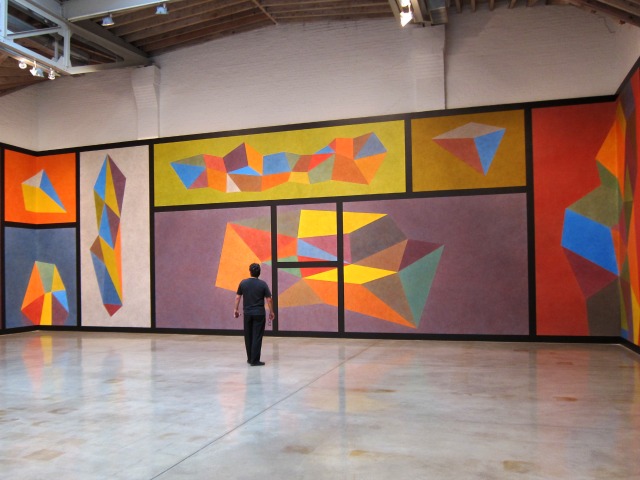I am almost fully certain that I am soulmates with a dead person.
His name, fittingly, is Sol. Sol LeWitt, 1928-2007, Rest in Peace.
Sol was a conceptual and minimalist modern artist whom I’ve heard referred to as both, “The guy with the lines,” and “The guy who draws on walls.” We’ll address those labels later, but for now, please blindly accept this label as fact (unless you’ve seen his work, in which case, you probably already do): The guy was a genius.
Sol’s labels come with instructions – highly specific ones that tell others how to produce his art, which is still made and installed in galleries and museums around the world. An aesthetical emperor of sorts, he envisioned a work, worded a decree for exactly how to make it, and handed it off to his disciples to carry out. 1,000-some-odd people have taken part in installing Sol’s work at some point, many of who were and/or are students and young artists. Here’s a sample set of instructions:
“On a wall surface, any continuous stretch of wall, using a hard pencil, place fifty points at random. The points should be evenly distributed over the area of the wall. All the points should be connected by straight lines.” –Wall Drawing #118: Fifty randomly placed points connected by straight lines
Go ahead, roll your eyes because art, right? No attempt at poetically describing the astounding beauty of Wall Drawing #118 can mask its premise of a guy thinking up some lines, writing some instructions, hiring some people to follow them and giving the piece the most boring of titles because it’s too profound to be trivialized by something poetic. But could you write three sentences that translate into a 50-pegged instrument with thousands of strings vibrating in rhythm; an oscillating machine hinged on hair-thin wires; a sketching of particles and force fields all strung together into a 3D micro-universe?
And there’s my poetic trivialization of 2,450 lines on a big, white wall.
It recently took eight people more than 1,280 hours to install another one of his works, Wall Drawing #564: Complex forms with color ink washes superimposed, the current exhibition at the Paula Cooper Gallery in Manhattan’s gallery district, Chelsea. I’ll take the trivializing liberty of describing this work as a transformation of three walls, each nearly three stories, into a continuous mural of giant geometric shapes. Because of the layered painting technique, they trick the eye from deciding which angles are concave and convex, and suddenly you find yourself standing in a forest of colossal crystals that shift and change shape with every breeze of a blink.
Wall Drawing #564. Photo cred: Glenwood.
He wrote very detailed instructions for the creation of this. I will never know the names of the eight people that followed them. I assume they are all altruists. Why is it that Sol gets the artistic credit when he was (and is) not the one pouring thousands of hours into making the art he conceived? Without doing the manual labor required to realize his great ideas, is he even an artist at all? Sol, why didn’t you draw your own damned lines? You thought of them.
Let’s talk arts and crafts for a minute, because there’s a difference. Crafts are the underlying skill sets that we learn and practice, forming the groundwork for almost everything we do. Technical rules objectively judge craftsmanship as right or wrong, whether it’s for the composition of a photograph or the making of an omelet. Drawing straight lines, too, is a craft. Those who install Sol’s work practice and workshop his instructions at length before ever touching a wall. We all draw straight lines differently; for Sol’s works, he only intended them one way.
Art takes a craft and uses it to create something with meaning. Good art pushes the boundaries of what certain skills can do and turns technical dogmas into vehicles bound for the intangible, where there is no right or wrong – only questions. Does it make you feel? Does it make you think? Great art reinvents a craft altogether.
But all art first requires a tremendous amount of time learning the craft behind it. NPR radio host Ira Glass has preached that those in creative fields must torturously slog through producing an ineffable volume of work they aren’t happy with before they finally begin to feel artistic satisfaction with what they’re making. Malcolm Gladwell popularized the daunting rule that it takes ten thousand hours of practice before you reach a level of expertise. In order to make art, the craft must be mastered first. Rules must be learned in order for them to be broken.
There’s a lot of great craftsmanship that has magical moments and sometimes slips by as art (indie music, right?). Fake it ‘till you make it – I am not opposed. But problems arise when we become too comfortable faking and think ourselves artists before we’ve put in our hours. We don’t just compromise our audience, we compromise ourselves, never reaching our full potential because we’d rather be proud than patient. We all have some great ideas swimming around in our skulls; bright ideas aren’t terribly difficult to conjure. But making what we see in our minds into things we can see in front of us is extraordinarily difficult, and we cannot cross the gap between our heads and hands if we don’t have an encyclopedic knowledge of how to build the necessary bridge.
Drawing on walls. Here’s the thing about it: eventually, walls get used for something else. Sometime shortly after Oct. 12, some people will come to Paula Cooper with buckets of white paint and roll it all over the crystals until they’re gone.
Which, too, is part of Sol’s art. Sol’s grand idea was that his art could be both ephemeral and eternal, lasting for only so long yet continually created forever – beautiful, but an extraordinarily difficult bridge to build into reality. He started with instructions (because mortality); in order for instructions to be accurately followed without his supervision, they must be fairly fundamental, hence the simple components of lines and shapes. In order for the instructions to continue to be executed, there must be a demand; demand requires a limited supply; to limit the supply, he exploited the temporary nature of walls. Genius.
Years after he has passed away, there are still new works being created by Sol LeWitt, and he is still teaching others the craft of making them. Paula Cooper’s eight are well on their way to their ten thousands, which is exactly what he intended. His art is the repeated teaching of its craft.
Who’s the altruist now?
If you still see this as a back door out of manual labor, look up Sol’s resumé. He studied art at Syracuse University and again, later, at the School of Visual Arts. He did administrative work in the art department of Seventeen magazine, graphic design for architect I.M. Pei and sat as a night clerk at MoMA. In his free time, he set up a studio in Manhattan’s Lower East Side and entrenched himself in the surrounding artistic community – Dan Flavin, Robert Rauschenberg, Frank Stella, Jasper Johns. He spent exponentially more than ten thousand hours learning his craft before deciding to teach others to draw lines on walls.
I once heard it said, “An artist is someone who decides.” Sol not only decided to make a form of art that is founded on instructional decisions; he invented it. Rather than drawing his own damned lines, Sol created a new way of processing, and thereby a new process. Soulmate.
And now, having made it out of the crystal forest, I find myself a few hours into my most newly adopted, profoundly trivial craft: the poetic description of lines.
Gabrielle Lipton is a freelance writer living in Manhattan. Previous publication includes Slate, IndieWIRE, Paste and Relapse; side projects include her website and concocting unusual flavors of homemade ice cream.





